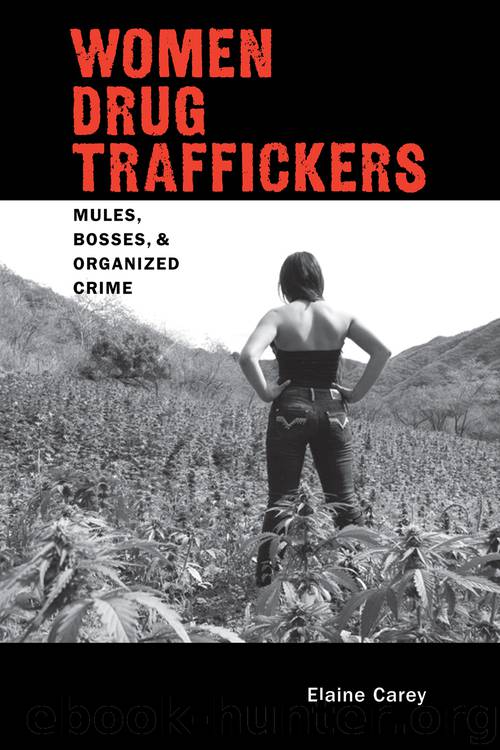Women Drug Traffickers by Elaine Carey

Author:Elaine Carey [Carey, Elaine]
Language: eng
Format: epub
Publisher: University of New Mexico Press
Published: 2014-09-15T07:00:00+00:00
Figure 20. Women with contraband. H. J. Anslinger Papers, box 14, folder 5, image 227, Eberly Family Special Collections Library, Pennsylvania State University, University Park, PA. This is most likely a staged photo.
A native of El Paso, Palm was a dealer in Los Angeles and perhaps a distributor for Big Mike because he continually pleaded the Fifth Amendment when questioned about his own involvement, although he did admit to purchasing an ounce of uncut heroin at $400 (2012: $3,415) in Mexico. He brought it back to Los Angeles, where he sold it. He also admitted to having business contacts in Mexicali-Calexico and Ciudad Juárez–El Paso. Under pressure from the commission, Palm revealed that Big Mike had interests (perhaps his own poppy fields) in Sinaloa and that he also maintained laboratories in Tijuana. Palm also reported that Big Mike worked closely in his drug business with his brother-in-law Al Galindo.92
Agent Vader filled in the rest. Big Mike was reputed to be Mike Barragán Bautista, who owned one of the largest taxi companies in Tijuana as well as the dog-racing track. As some addicts indicated, his taxi drivers sought clients as well as delivered heroin to different locations on both sides of the border.93 Addicts described crossing into Tijuana and getting a ride in one of the taxis to another destination to purchase drugs. Despite the efforts of U.S. customs and Mexican agents, they were never able to purchase heroin directly from Big Mike, only from his runners. Thus, Big Mike maintained distance between himself and the actual sale of drugs. From undercover informants, Vader had learned that Big Mike supplied dealers as far away as Dallas. In addition, he and his wife, Ismelda Galindo Barragán, owned a large and successful “house of ill repute” in Tijuana. In that bordello, Ismelda also sold heroin. (Consul General Domínguez interrupted Vader’s testimony and asked him for specific information regarding the Barragáns; Vader replied as best he could.) Like her husband’s taxi company, Ismelda’s business gave her an opportunity to exchange pesos and dollars and to mask the sale of narcotics.94
All the women mentioned in the testimony had lives unlike those portrayed in the popular literature on drug trafficking that emerged in the 1970s and 1980s, such as Don Henry Ford’s Contrabando, a picaresque escapade about a gringo trafficker. Don Ford told anthropologist Howard Campbell: “When I operated, few women were involved. . . . It was a more male-dominated [activity] because of their culture, in rural areas women didn’t participate in business . . . very much.”95 Ford argued that with the introduction of cocaine, more women entered the trade as traffickers.
Ford’s reading of drug trafficking, like many of the biographies and pseudo-memoirs of the narcos, reinforces the sense of masculine bravado surrounding the narcotics trade, which is then repeated by scholars who disregard the involvement of women. The introduction of cocaine brought greater numbers of women into the trade because more profit was available. Women worked as mules to pay off the debts
Download
This site does not store any files on its server. We only index and link to content provided by other sites. Please contact the content providers to delete copyright contents if any and email us, we'll remove relevant links or contents immediately.
| Africa | Americas |
| Arctic & Antarctica | Asia |
| Australia & Oceania | Europe |
| Middle East | Russia |
| United States | World |
| Ancient Civilizations | Military |
| Historical Study & Educational Resources |
Underground: A Human History of the Worlds Beneath Our Feet by Will Hunt(11992)
Sapiens by Yuval Noah Harari(5273)
Navigation and Map Reading by K Andrew(5006)
The Sympathizer by Viet Thanh Nguyen(4280)
Barron's AP Biology by Goldberg M.S. Deborah T(4073)
5 Steps to a 5 AP U.S. History, 2010-2011 Edition (5 Steps to a 5 on the Advanced Placement Examinations Series) by Armstrong Stephen(3673)
Three Women by Lisa Taddeo(3335)
Water by Ian Miller(3103)
The Comedians: Drunks, Thieves, Scoundrels, and the History of American Comedy by Nesteroff Kliph(3021)
Drugs Unlimited by Mike Power(2526)
A Short History of Drunkenness by Forsyth Mark(2184)
The House of Government by Slezkine Yuri(2147)
DarkMarket by Misha Glenny(2134)
And the Band Played On by Randy Shilts(2104)
The Library Book by Susan Orlean(2029)
Revived (Cat Patrick) by Cat Patrick(1936)
The Woman Who Smashed Codes by Jason Fagone(1904)
Birth by Tina Cassidy(1838)
The Absolutely True Diary of a Part-Time Indian by Sherman Alexie(1834)
